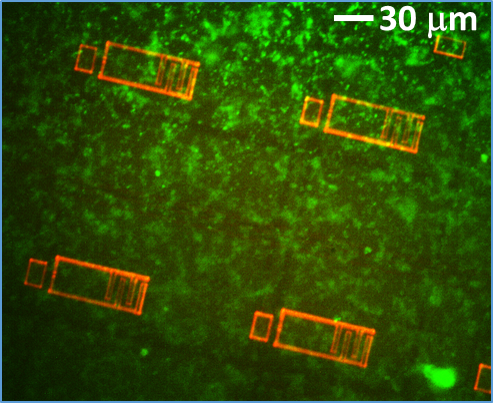Wet circuits for biology research
Marc Dandin is teaming up with researchers from the Department of Biological Sciences at CMU to create electronics for use in cell research.
You don’t have to be an engineer to know that water and electronics don’t mix. But if you want to use a sensing circuit to study small-scale features in a community of cells, the electronics must find a way to accommodate the cell’s aqueous environment. The circuit also cannot affect the cells in a way that invalidates the data.
Marc Dandin, an assistant professor in the department of electrical and computer engineering, is researching ways to make circuits that are able to function in wet environments for cell research. He is working with N. Luisa Hiller, an associate professor in the biological sciences department, who will use the circuits to explore how immune cells are affected by particles released from Streptococcus pneumoniae cells. The work is funded by a recent two-year DSF Charitable Foundation award through the Mellon College of Science.

Source: Lydia Eutsey
To achieve such high precision sensing, bacteria are cultured on an electronic chip.
“The project fits into a greater theme, which centers on interfacing electronics with biological species,” Dandin said. “Dr. Hiller’s work and my work merge as we are both interested in studying cellular and bacterial processes and how they take part in disease progression.”
The bacteria, Streptococcus pneumoniae, can cause a variety of diseases, including pneumonia. This bacterium is a particularly exciting model because it is relevant to common health issues, tackles fundamental questions about microbial life, and the results can be generalized and used to guide similar research about other bacteria.
Most cells release extracellular vesicles (EV), a cell-to-cell mailing system that enables communication between cells. The goal of Dandin and Hiller’s project is to expand our knowledge on how bacterial EVs affect the immune system of a host, specifically how they activate or inhibit immune defenses.
For this research project, immune cells are grown on a circuit chip in an incubator that simulates the environment inside a host. The electronics are designed to collect data about an entire population of cells overlying the circuit while also preserving single cell resolution in the measurements.
“With our technology, you can also look at things at a very fine level, almost at single-cell level,” Dandin said. “It allows us to understand what's happening with much more fine spatial and temporal resolution.”
We found that multidisciplinary research really helps make giant leaps instead of tiny, little pushes in each of these fields. CMU is a great institution for this kind of multidisciplinary research.
Marc Dandin, Assistant Professor, Electrical and Computer Engineering
The unique challenges associated with using circuits in incubators and other wet environments allow ECE students to push their expectations of electronics’ applications. The students also learn about biology, even without formal coursework.
“We found that multidisciplinary research really helps make giant leaps instead of tiny, little pushes in each of these fields,” Dandin said. “CMU is a great institution for this kind of multidisciplinary research.”
